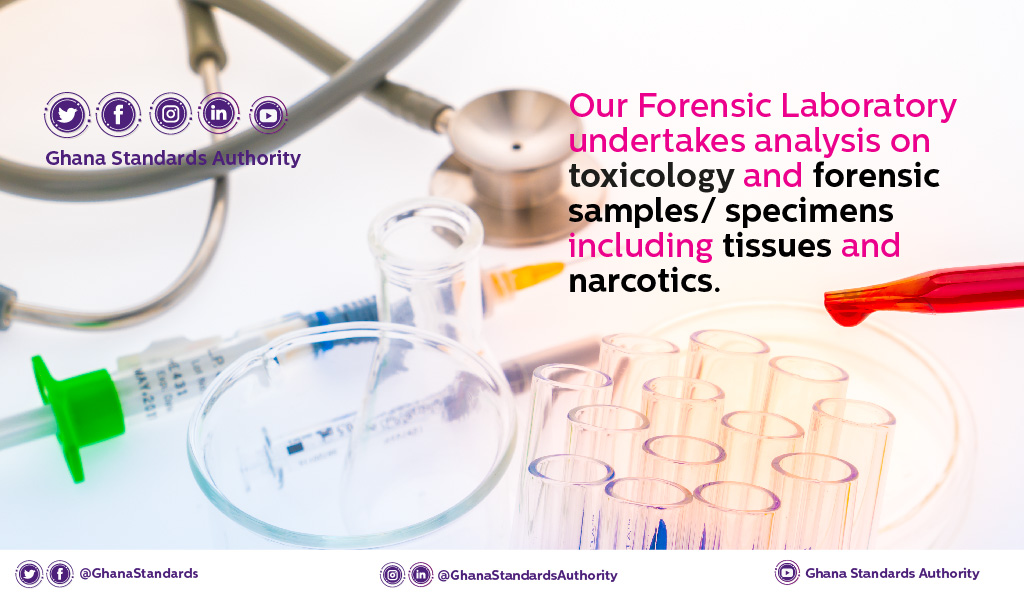
The department undertakes tests and analysis on various products and samples for the purposes of quality, investigation and medical diagnoses. There are four (4) laboratories under the department.
Drugs laboratory which undertakes analysis on drugs and related products.
Cosmetics Laboratory which undertakes chemical analysis on cosmetics and related products.
Forensic Laboratory which undertakes analysis on forensic samples including tissues and narcotics.
Histopathology laboratory which undertake tests on tissues and other samples for medical diagnoses.
- Analgesics/antipyretics
- Tranquilizers
- Spasmolytics
- Anti-histamines/Anti-allergics
- Anti-hypertensive
- Anti-bacterials/anti-fungals
- Antiprotozoal Agents
- Anti-depressants
- Anti-malarials
- Antiseptics
- Antibiotics
- Antacids
- Anti-diabetics
- Ophthalmic Agents
- Tonic/Appetite Stimulants
- Tonic/Appetite Stimulants
- Vitamins
- Cough syrups
- Infusions
- Oral Rehydration Salts (ORS)
- Pharmaceutical Raw Materials
- Supplements
- Contraceptives (Oral, Condom etc)
- Stimulants
- Other Pharmaceutical/Orthodox Drugs
- Disinfectants
- Veterinary Products/Drugs
- Herbal Preparation
- Hand Sanitizers
- Related Substances
- Pharmaceutical Working Standards
- Diapers
- Sanitary Pads
- Sanitary Towels
- Cotton Wool
- Gauze
- Surgical Gloves
- Plasters
- BandagesAreas of analysis at the Drugs Laboratory include:
Areas of analysis at the Cosmetics Laboratory include:
| Liquid Detergent | Skin Powder |
| Powdered Detergent | Toothpaste |
| Laundry Soap | Hair Oil |
| Toilet Soap | Nail Polish/Remover |
| Medicated/Carbolic Soap | PerfumesOil |
| Hair Relaxer | Moisturizers |
| Shampoo (Hair) | Hand Sanitizers |
| Setting Lotion | Showers/Bath Gels |
| Conditioner (Hair) | Skin Pomade/Creams |
| Hair Pomade/Creams |
Areas of analysis at the Forensic Laboratory include:
- Alcohol test in biological fluids (blood, urine etc.)
- Common poisons in food and drinks
- Common poisons in human tissues and fluids. (Liver, kidney, stomach contents, urine blood etc.)
- Test for Heavy metals in biological tissues and fluids
- Test for Heavy metals in food, drinks and other substances
- Test for narcotic and psychotropic substances (Cocaine, Heroin, Cannabis
- Amphetamines, Pethidine, Benzodiazepines, Morphines, Barbiturates etc)
- Test for narcotic and psychotropic drugs in urine, blood, other body fluids, food drinks and other suspected dozed substances.
- Lithium levels in serum.
- Receiving and sampling of suspected narcotic substances submitted by the Law Enforcement Agencies and quantification of concentration levels.
Sample sizes for analysis of drugs and cosmetics
Sample size for analysis of drug samples is determined by requirement in test methods used. Sample size is also determined after discussion with client based on client on client request.
Sample size for analysis of cosmetics samples varies with each product and how it is packaged.
The sample size for forensic toxicology samples are indicated below
| Test | Sample size |
|---|---|
| Postmortem samples for toxicology | At least five (5) milliliters |
| Blood samples for alcohol levels: | At least five (5) milliliters |
| Serum samples for lithium determination | At least three (3) milliliters |
| Urine samples for Drugs and Alcohol Test | At least fifty (50) milliliters |
| Urine samples for Heavy metals determination | At least ten (10) milliliters |
| Food samples for toxicology: | At least twenty (20) grams |
| Drinks/Beverages for toxicology and psychotropics | At least fifty (50) milliliters |
The Drugs Laboratory works with the under listed test methods
- British Pharmacopoeia (BP)
- U.S. Pharmacopoeia (USP)
- International Pharmacopoeia (IP)
- ISO Test Methods
- GS Test Methods
- GS ISO Test Methods
- Laboratory prepared and Validated Test Methods
- Ghana Herbal Pharmacopoeia
The Cosmetics Laboratory works with the Ghana Standards (GS) and British Pharmacopoeia (BP)
The Forensic Laboratory works with Standard Test Methods (Clarke’s Analysis of Drugs
and Poisons) and Laboratory Validated Test Methods (In-house Validated Test Methods).
